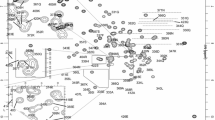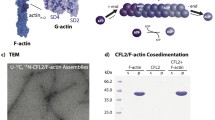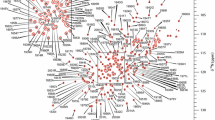Abstract
α-Catenin is a filamentous actin (F-actin) binding protein that links the classical cadherin–catenin complex to the actin cytoskeleton at adherens junctions (AJs). Its C-terminal F-actin binding domain is required for regulating the dynamic interaction between AJs and the actin cytoskeleton during tissue development. Thus, obtaining the molecular details of this interaction is a crucial step towards understanding how α-catenin plays critical roles in biological processes, such as morphogenesis, cell polarity, wound healing and tissue maintenance. Here we report the backbone atom (1HN, 15N, 13Cα, 13Cβ and 13C′) resonance assignments of the C-terminal F-actin binding domain of αN-catenin.
Similar content being viewed by others
Explore related subjects
Discover the latest articles, news and stories from top researchers in related subjects.Avoid common mistakes on your manuscript.
Biological context
The cadherin–catenin complex is the central molecular component of the intercellular linkage at the adherens junction (AJ). It connects the extracellular bonds made of cadherin homotypic interactions to the intracellular actin cytoskeleton and signaling elements. This physical link is essential for maintaining the cell and tissue structure and integrity during developmental processes, such as morphogenesis. In the classical cadherin–catenin model, α-catenin is the adaptor protein that anchors the cytosolic cadherin to actin cytoskeleton by binding indirectly to cadherin through β-catenin, a cadherin binding protein, and directly to F-actin.
α-Catenin is a 100 kDa protein comprising of three structural domains, N-, M- and C-terminal domains, which are also referred to as VH1 (Vinculin Homology domain 1), VH2 and VH3, respectively (Ishiyama et al. 2013; Rangarajan and Izard 2013). N domain is responsible for β-catenin binding or homo-dimerization that occurs in a mutually exclusive manner, while the C domain is for F-actin binding. M domain is known to have multiple ligands such as vinculin, afadin and other actin binding proteins, and thought to be a regulatory region of the protein (Kobielak and Fuchs 2004). Mammals express three subtypes, αE- (epithelial), αN-O (neuronal) and αT-catenin (heart and testis), with distinct tissue expression.
Recent studies highlighted α-catenin as a mechanical force sensor of cell–cell adhesion. αE-catenin under actomyosin-dependent tension at AJs was found to recruit vinculin, and this event was shown to involve structural transition of α-catenin from the autoinhibited conformation to the activated conformation (le Duc et al. 2010; Yonemura et al. 2010). Several independent single molecule studies recently determined that a similar range of force (5–15 pN) is involved in conformational changes of the αE-catenin M domain, as well as α-catenin-mediated binding of a cadherin–catenin complex to F-actin in a two-state binding model (Yao et al. 2014; Buckley et al. 2014). The forces measured were in the same order of magnitude as the force constitutively experienced by E-cadherin molecules at AJs (Borghi et al. 2012). These results provided direct evidences for α-catenin functionality modulated by the external mechanical force. However, the molecular details of the force-dependent interaction between α-catenin and F-actin remain largely unknown. To gain insight into dynamic α-catenin association with F-actin in solution, we have assigned the backbone resonances of C-terminal F-actin binding domain (ABD) of αN-catenin as the first step of our NMR investigation. αN-catenin has been shown to participate in neural cell–cell adhesion during development (Uchida et al. 1994). It shares high sequence identity to αE-catenin (82 %), but has less affinity in homodimerization (Desai et al. 2013; Pokutta et al. 2014).
Methods and experiments
Sample preparation
The gene encoding the C-terminal domain of αN-catenin (a.a. 656–905) from mouse (Mus musculus) was cloned into the expression vector pGEX4T1 and transformed into E. coli strain BL21 (DE3) codon plus (Agilent Technologies). To obtain isotopically enriched (15N/13C/2H) NMR samples, the bacterial cells were grown in M9 minimal media containing 13C-glucose and 15NH4Cl in D2O at 37 °C, and when the cell density reached to OD600 = 0.6, the protein expression was induced by adding 0.5 mM of IPTG for ~12 h at 16 °C. The protein was harvested in soluble cell lysate and purified as described previously (Ishiyama et al. 2013). The protein constructs without the C-terminal flexible extension (a.a. 651–862) and the extension alone (a.a. 858–905) were also made and analyzed to aid the assignments of the whole C-terminal domain. All purified protein contained a non-native dipeptide Gly-Ser on its N-terminus derived from the plasmid after the thrombin cleavage of GST-tag.
NMR spectroscopy
NMR spectra of αN-catenin C-terminal domain (a.a. 656–905) were collected at 30 °C on 800 MHz Bruker Avance II spectrometer equipped with cryogenic triple resonance probe head (TCI). NMR samples contained 0.3–0.4 mM of protein in the NMR buffer [20 mM potassium phosphate (pH 6.5), 150 mM NaCl, 1 mM TCEP, and 1 mM NaN3 in 95/5 (%) of H2O/D2O]. Backbone resonance assignments were obtained by the following TROSY-based 3D experiments; HNCO, HN(CA)CO, HN(CO)CA, HNCA, HN(COCA)CB, HN(CA)CB and 15N edited NOESY (τ m = 80 ms). Temperature in all experiments was calibrated with 99.8 % d 6-methanol. Chemical shifts of each nucleus were calibrated directly or indirectly by an external 10 mM DSS 1H resonance signal in the same buffer as used for the protein sample. All data were processed by using NMRPipe (Delaglio et al. 1995) and analyzed by using NMRViewJ (Johnson and Blevins 1994) software.
Assignments and data deposition
We have assigned ~95 % of the backbone atom resonances of the C-terminal ABD of αN-catenin (a.a. 656–905); 94.6 % of non-proline amide, 97.6 % of Cα, 96.7 % of Cβ, and 97.2 % of C′ (Fig. 1). Figure 2 shows the chemical shifts (15N, 13Cα, 13Cβ, and 13C′) based secondary structure prediction obtained by TALOS-N (Shen and Bax 2013). All identified secondary structure elements coincide with the previously solved high-resolution crystal structure of the C-terminal ABD of αN-catenin (a.a. 651–905), which consists of a five-helix bundle capped with a preceding short α-helix and a β-hairpin on the N-terminal side, and a 44-residue extension on the C terminus (Ishiyama et al. 2013). The chemical shifts of the C-terminal extension (a.a. 862–905) have small deviations from those of random coils. It is thus the region is likely to be disordered, correlating to the fact that the electron density map was not observed for this region in the protein crystal structure. This C-terminal extension is known to have a significant impact to the F-actin binding of α-catenin (Pokutta et al. 2002; Pappas and Rimm 2006). Interestingly, in the crystal structure of homodimerized human αE-catenin (a.a. 82–906), the C-terminal extension of one of two ABDs formed an α-helix that made contacts to the internal domains (Rangarajan and Izard 2013). This may imply that the corresponding region in αN-catenin could also form a helix in a certain condition such as ligand presence as they shares high sequence identity.
2D 15N–1H TROSY spectrum of 13C/15N/2H labeled αN-Catenin C-terminal F-actin binding domain (a.a. GS + 656–905) acquired on 800 MHz Bruker AVANCE II spectrometer at 30 °C. The sample contained 0.35 mM of protein, 20 mM potassium phosphate (pH 6.5), 150 mM NaCl, 1 mM TCEP and 1 mM NaN3 in 95/5 (%) of H2O/D2O
Probabilities of the secondary structure as a function of amino acid sequence provided by TALOS-N (α-helix: blue, β-sheet: orange). Secondary structures determined in the crystal structure (PDB: 4K1O) is shown on top of the histogram (α-helix: box, β-sheet: arrow). The residues missing in electron densities in the crystal structure are shown in broken line
Unassigned residues due to the poor coherence transfers reside at the C-terminal bundle capping region (S857–M860), where the backbone atoms possibly undergo slow conformational exchange. The other successive residues unassigned are D705–D706 and D768–S769, which lie on the short loop between α-helices 2 and 3 neighboring to the above bundle capping region and those between α-helices 4 and 5, respectively. The assignments reported here will provide a basis of the further analysis on the α-Catenin F-actin binding domain by NMR. The chemical shifts of backbone atoms were deposited in the BioMagResBank (http://www.bmrb.wisc.edu) under accession number 26833.
References
Borghi N, Sorokina M, Shcherbakova OG, Weis WI, Pruitt BL, Nelson WJ, Dunn AR (2012) E-cadherin is under constitutive actomyosin-generated tension that is increased at cell–cell contacts upon externally applied stretch. Proc Natl Acad Sci USA 109:12568–12573. doi:10.1073/pnas.1204390109
Buckley CD et al (2014) Cell adhesion. The minimal cadherin–catenin complex binds to actin filaments under force. Science 346:1254211. doi:10.1126/science.1254211
Delaglio F, Grzesiek S, Vuister GW, Zhu G, Pfeifer J, Bax A (1995) NMRPipe: a multidimensional spectral processing system based on UNIX pipes. J Biomol NMR 6:277–293
Desai R, Sarpal R, Ishiyama N, Pellikka M, Ikura M, Tepass U (2013) Monomeric alpha-catenin links cadherin to the actin cytoskeleton. Nat Cell Biol 15:261–273. doi:10.1038/ncb2685
Ishiyama N et al (2013) An autoinhibited structure of alpha-catenin and its implications for vinculin recruitment to adherens junctions. J Biol Chem 288:15913–15925. doi:10.1074/jbc.M113.453928
Johnson BA, Blevins RA (1994) NMR View: a computer program for the visualization and analysis of NMR data. J Biomol NMR 4:603–614. doi:10.1007/BF00404272
Kobielak A, Fuchs E (2004) Alpha-catenin: at the junction of intercellular adhesion and actin dynamics. Nat Rev Mol Cell Biol 5:614–625. doi:10.1038/nrm1433
le Duc Q, Shi Q, Blonk I, Sonnenberg A, Wang N, Leckband D, de Rooij J (2010) Vinculin potentiates E-cadherin mechanosensing and is recruited to actin-anchored sites within adherens junctions in a myosin II-dependent manner. J Cell Biol 189:1107–1115. doi:10.1083/jcb.201001149
Pappas DJ, Rimm DL (2006) Direct interaction of the C-terminal domain of alpha-catenin and F-actin is necessary for stabilized cell–cell adhesion. Cell Commun Adhes 13:151–170. doi:10.1080/15419060600726142
Pokutta S, Drees F, Takai Y, Nelson WJ, Weis WI (2002) Biochemical and structural definition of the lafadin- and actin-binding sites of alpha-catenin. J Biol Chem 277:18868–18874. doi:10.1074/jbc.M201463200
Pokutta S, Choi HJ, Ahlsen G, Hansen SD, Weis WI (2014) Structural and thermodynamic characterization of cadherin.beta–catenin.alpha-catenin complex formation. J Biol Chem 289:13589–13601. doi:10.1074/jbc.M114.554709
Rangarajan ES, Izard T (2013) Dimer asymmetry defines alpha-catenin interactions. Nat Struct Mol Biol 20:188–193. doi:10.1038/nsmb.2479
Shen Y, Bax A (2013) Protein backbone and sidechain torsion angles predicted from NMR chemical shifts using artificial neural networks. J Biomol NMR 56:227–241. doi:10.1007/s10858-013-9741-y
Uchida N, Shimamura K, Miyatani S, Copeland NG, Gilbert DJ, Jenkins NA, Takeichi M (1994) Mouse alpha N-catenin: two isoforms, specific expression in the nervous system, and chromosomal localization of the gene. Dev Biol 163:75–85. doi:10.1006/dbio.1994.1124
Yao M et al (2014) Force-dependent conformational switch of alpha-catenin controls vinculin binding. Nat Commun 5:4525. doi:10.1038/ncomms5525
Yonemura S, Wada Y, Watanabe T, Nagafuchi A, Shibata M (2010) alpha-Catenin as a tension transducer that induces adherens junction development. Nat Cell Biol 12:533–542. doi:10.1038/ncb2055
Acknowledgments
This work was supported by CIHR Grant (MOP 130267) to M.I. The 800 MHz NMR spectrometer used in this study was funded by the Canada Foundation for Innovation. M.I. holds Canada Research Chair in cancer structural biology.
Author information
Authors and Affiliations
Corresponding author
Ethics declarations
This article does not contain any studies with human or animal subjects.
Rights and permissions
About this article
Cite this article
Nishikawa, T., Ishiyama, N., Wang, F. et al. Backbone resonance assignments of the F-actin binding domain of mouse αN-catenin. Biomol NMR Assign 11, 21–24 (2017). https://doi.org/10.1007/s12104-016-9713-8
Received:
Accepted:
Published:
Issue Date:
DOI: https://doi.org/10.1007/s12104-016-9713-8






